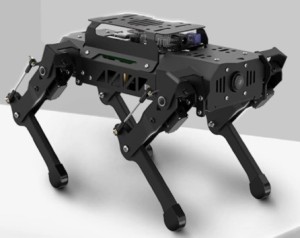
Revolutionizing Industrial Asset Monitoring: The Role of Robotic Dogs in Ensuring Infrastructure Integrity
In the rapidly evolving world of industrial automation, robotic dogs are poised to transform asset integrity monitoring, particularly in high-risk environments such as petrochemical plants and onshore oil rigs. These advanced machines, like those developed by Boston Dynamics, are revolutionizing the way industries maintain safety, efficiency, and infrastructure integrity. Equipped with cutting-edge sensors, cameras, and AI-driven analytics, robotic dogs offer a game-changing solution for real-time, continuous monitoring of critical assets. Traditional methods, such as manual inspections and fixed monitoring systems, although effective, come with significant limitations in terms of coverage, frequency, and safety risks. Human inspections are time-consuming, costly, and often dangerous, especially in hazardous environments. Fixed sensors, while useful, fail to provide comprehensive coverage, particularly in hard-to-reach or dynamic areas. Robotic dogs, on the other hand, are designed for mobility, flexibility, and autonomy, making them ideal for inspecting areas that would otherwise pose a risk to human workers. Their ability to move freely through industrial facilities, navigate obstacles, stairs, and confined spaces, allows them to inspect equipment located in elevated or confined areas with ease. For instance, in sprawling industrial sites, such as petrochemical compounds or oil rigs, robotic dogs can seamlessly patrol pipelines, storage tanks, and structural components, reducing the need for human involvement in dangerous areas. One of the key advantages of robotic dogs is their ability to be equipped with a variety of sensors that monitor different aspects of asset integrity. These sensors, including thermal cameras, acoustic detectors, gas sensors, and vibration monitors, enable them to detect physical damage, temperature changes, leaks, and abnormal vibrations, which could indicate potential failures. For example, thermal cameras can help identify overheating equipment or electrical faults, while acoustic sensors detect ultrasonic sounds that signal cracks or fractures in machinery. Gas detectors, meanwhile, are critical for identifying harmful emissions such as methane and hydrogen sulfide, which are common in petrochemical facilities and pose serious environmental and safety risks. Vibration monitors further enhance their functionality by detecting wear and tear or impending mechanical failures. This comprehensive approach to monitoring ensures that no potential issue goes unnoticed. Moreover, robotic dogs are equipped with AI capabilities, enabling them to operate autonomously and analyze data in real-time. This integration of artificial intelligence allows them to make decisions independently, adjusting their routes to investigate anomalies or alerting human operators when necessary. By leveraging AI, robotic dogs can reduce the burden on human workers, speed up the detection and resolution of issues, and even predict failures before they occur. For example, if a robotic dog detects an abnormal temperature rise in a piece of equipment, it can immediately notify maintenance teams, preventing potential downtime or damage. The proactive nature of these machines helps extend the operational life of critical assets and minimizes costly disruptions. In addition to their advanced monitoring capabilities, robotic dogs provide an added layer of safety in hazardous environments. Industrial facilities, such as oil rigs and petrochemical plants, often expose workers to extreme temperatures, toxic chemicals, or explosive gases. Robotic dogs can safely operate in these dangerous areas, conducting inspections without risking human lives. For instance, on oil rigs, where flare stacks and tanks often contain high levels of toxic gases, robotic dogs can perform critical inspections while humans remain at a safe distance. By reducing the need for human entry into hazardous zones, these robots help enhance workplace safety while maintaining thorough asset monitoring. Another major benefit of robotic dogs is their ability to reduce operational downtime. Traditional inspection methods often require equipment to be taken offline for maintenance, leading to disruptions in production and financial losses. However, with robotic dogs, many inspections can be performed while facilities remain operational. This predictive maintenance approach allows issues to be identified and addressed during the next scheduled maintenance window, preventing unexpected breakdowns and ensuring smooth operations. The applications of robotic dogs extend across various industrial settings. In petrochemical compounds, for instance, they can patrol the facility, inspecting pipelines, storage tanks, and pressure vessels for signs of damage or leaks. In addition, their gas detection sensors help identify harmful emissions, while thermal cameras monitor equipment temperature to prevent overheating and potential fires. Similarly, on onshore oil rigs, robotic dogs provide continuous monitoring of critical assets, such as wellheads and pipelines, in remote and challenging environments. They are particularly useful in areas where manual inspections would be difficult, dangerous, or costly. The future of asset integrity monitoring is likely to see even greater advancements in the use of robotic dogs. As AI technology continues to evolve, robotic dogs will become increasingly autonomous, requiring less human intervention. Integration with digital twins, a technology that creates virtual models of physical assets, could provide real-time updates on the condition of equipment and allow operators to predict maintenance needs with greater accuracy. Additionally, advances in sensor technology will further enhance the capabilities of robotic dogs, enabling them to detect even more subtle signs of asset degradation, such as microscopic cracks or material fatigue. In conclusion, robotic dogs are revolutionizing asset integrity monitoring in industrial facilities, offering a safer, more efficient, and proactive approach to maintaining critical infrastructure. Their mobility, advanced sensor capabilities, and real-time data analysis make them an invaluable tool for high-risk environments like petrochemical plants and onshore oil rigs. By adopting robotic dogs for asset monitoring, industries can reduce operational downtime, enhance safety, and ensure the long-term integrity of their assets. As this technology continues to develop, robotic dogs will play an increasingly important role in safeguarding industrial operations for years to come.
